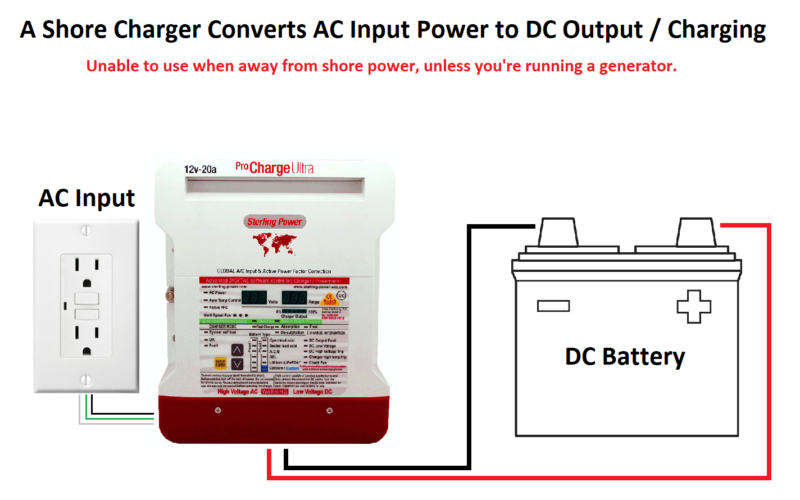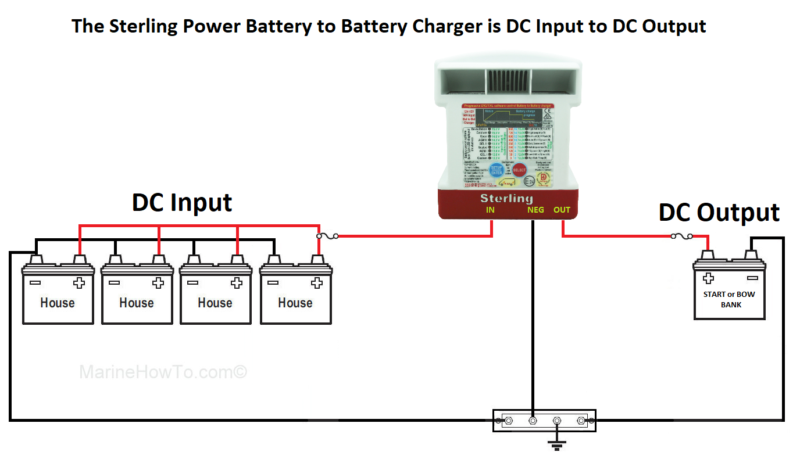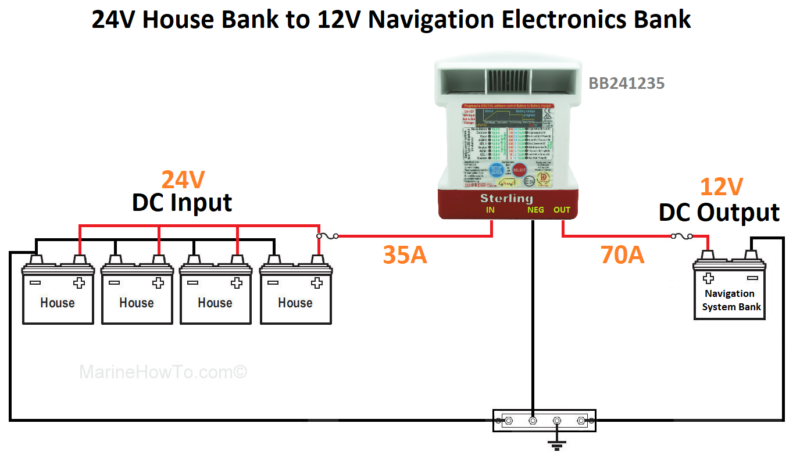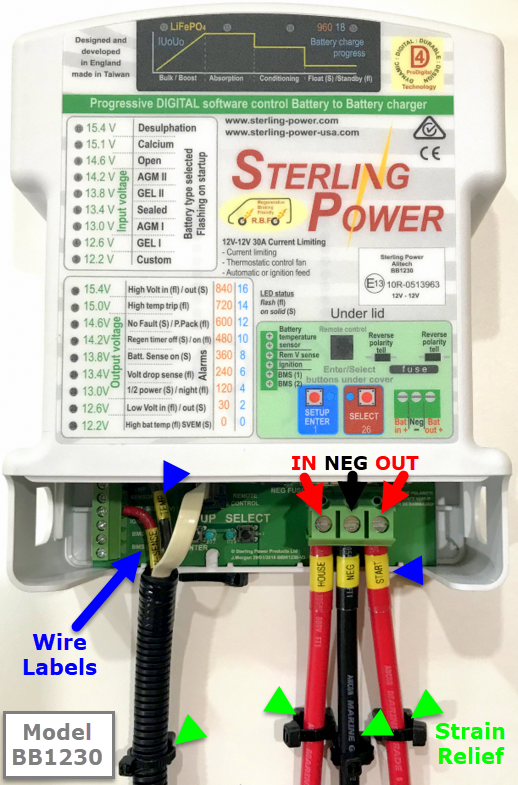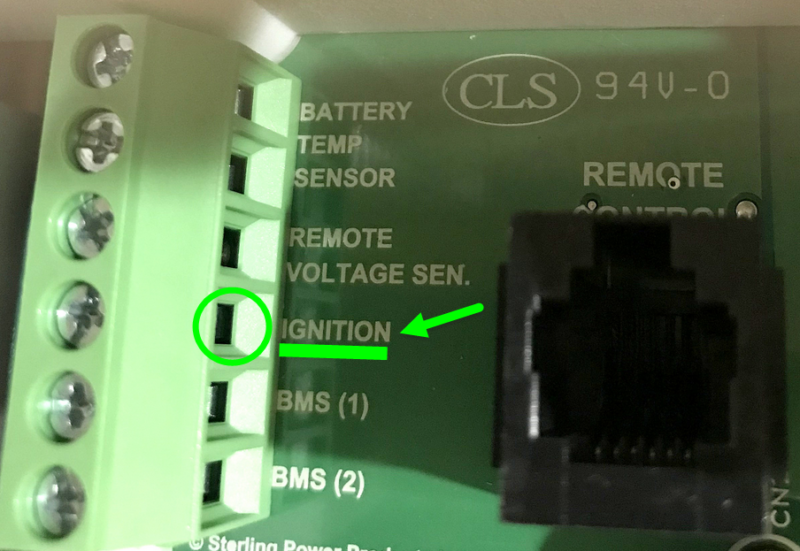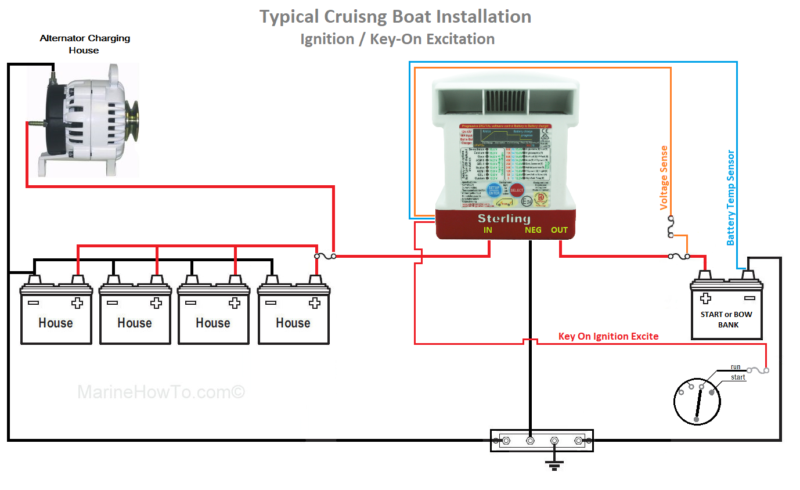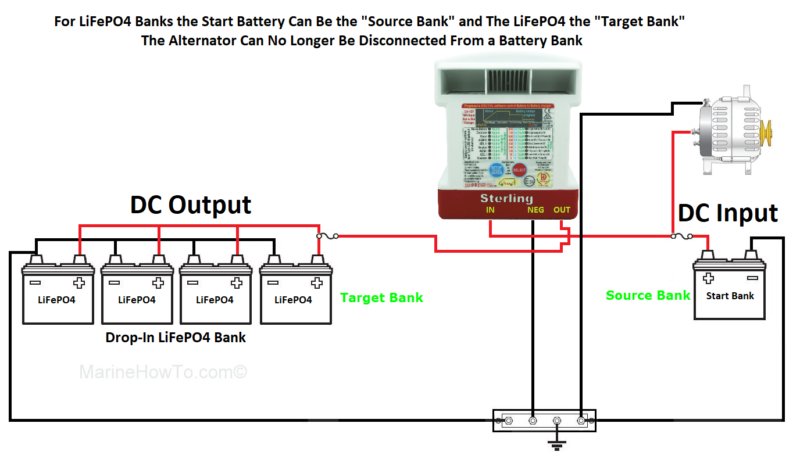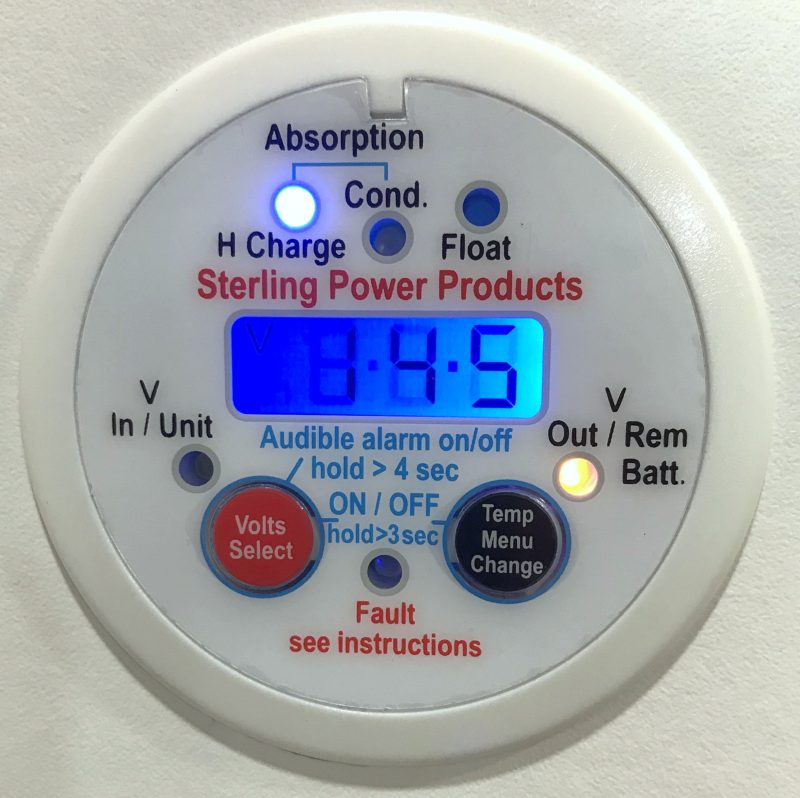The Sterling Power Pro Batt Ultra DC to DC Charger
In our continuing series on CMD’s or Charge Management Devices, this article examines and looks at the benefits of the Sterling Power DC to DC chargers and examines the installations where you may find them useful.
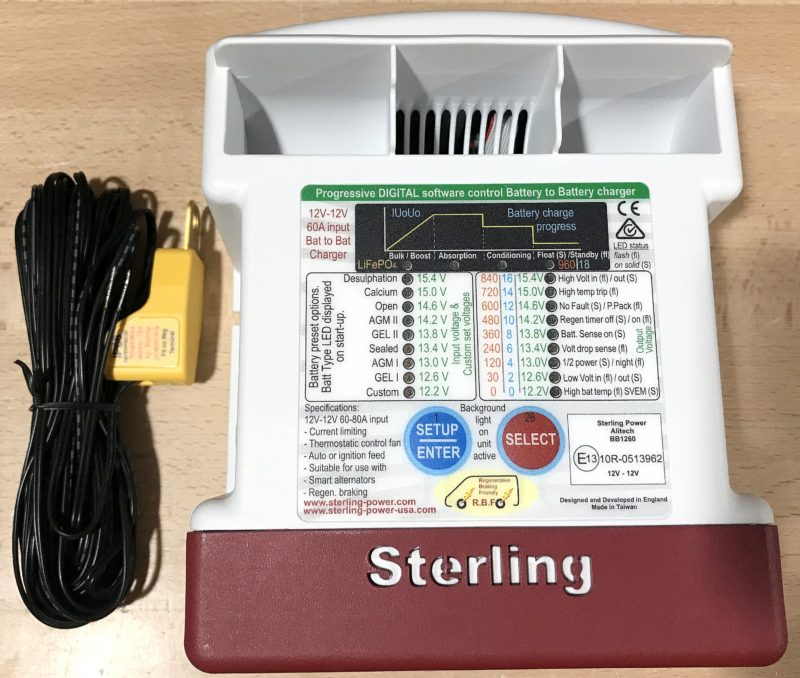 *This article includes the latest Sterling Power Pro Batt Ultra series of battery to battery chargers. The latest model is identified by the green stripe across the top of the face plate label.
*This article includes the latest Sterling Power Pro Batt Ultra series of battery to battery chargers. The latest model is identified by the green stripe across the top of the face plate label.
Definitions Used In This Article
- Battery to Battery Charger – A DC to DC charge source used for charging one bank of batteries from another bank of batteries
- B2B – Short form for battery to battery charger
- DC to DC Charger – A battery charger that operates from one DC battery bank to another
- CMD – Charge Management Device/s – Devices used to charge from battery to battery or alternator to battery
- Target Bank – The bank the B2B is feeding its output current to
- Source Bank – The bank the B2B is getting its input current from
- LiFePO4 – A lithium-ion battery chemistry – Lithium Iron Phosphate
- LFP – Short hand for LiFePo4
- BMS – A Battery Management System is the protection device for an LiFePo4 battery.
The Sterling Pro Batt Ultra B2B Charger
The above photo illustrates how the Pro Batt Ultra comes out of the box. It includes, as standard equipment, a battery temp sensor for the target bank/battery. The 12V to 12V BB1260 is shown and it’s quite small, much smaller than a 60A shore based charger. Size cab be scaled by comparing it to the battery temp sensor on the left. The small size means it can fit many places a standard AC to DC shore charger may not.
“Why Would I Want or Need a Pro Batt Ultra Battery to Battery Charger?”
The Pro Batt Ultra is the most feature filled, fully programmable DC to DC charge management device in existence today. On top of the cram-packed feature set they are actually priced quite reasonably. Compare what the Pro Batt Ultra is capable of, then compare it to other CMD’s that can’t do half of what the Pro Batt Ultra can do, and you see how good a value this charge management device is. Feature wise, the Pro Batt Ultra actually beats the very good Sterling Pro Charge Ultra shore chargers, and these are very good shore power chargers. The Pro Batt Ultra allows an owner to customize the absorption duration, a very useful feature when dealing with LiFePO4 batteries or even some lead acid and it also has dedicated voltage sensing. These are features not found in many AC chargers even at 3-4 times the price. While we can’t really compare a DC to DC charger to an AC to DC charger, output side charging features count no matter what the charge device is.
When You Would Use a DC to DC Charger vs. Other CMD’s
- Differing On-Board Battery Types/Chemistries – eg: GEL House > AGM Start or AGM Start > LiFePO4 “Drop-In” etc.
- Differing On-Board Bank Voltages – eg: 12V House > 24V Windlass or Thruster Bank or 24V House to 12V Navigation Electronics Bank
What is a Pro Batt Ultra?
Very simply put the Pro Batt Ultra is an extremely full featured battery charger, more so than most AC powered shore chargers you’ll find. That’s it. The only difference between a shore charger and the Pro Batt Ultra is that the Pro Batt Ultra can be powered by another battery bank so that it can be used with all your charge sources to charge the target battery.
Pro Batt Ultra = Buck or Boost
The Pro Batt Ultra can not only “buck” voltage (buck means reduce beyond input) but, unlike most DC to DC chargers, it can also “boost” voltage (boost means increase beyond input). CMD’s such as an ACR/VSR/Combiner, Echo Charger or Digital Duo Charger can only reduce voltage to the target bank and can not increase it. None of the aforementioned CMD’s can float a target bank independently from the source bank but the Pro Batt Ultra can float independently.
For example the Pro Batt Ultra 12V to 12V models can take an input of 14.1V from a source bank and output a higher voltage to charge the target bank that may require 14.8V. Another major plus is the Pro Batt Ultra is available for both like voltage and for mixed voltage vessels where both 12V and 24V banks are installed.
Output Current vs. Input Current: Please be aware that unlike a shore based charger, the Sterling B2B chargers are rated based on max input current. In other words a BB1230 is not a 30A output but rather a 30A input. You will get less than 30A on the output side. This is done so you know the maximum the unit can pull from the “source bank” which is a critical measurement to know. The average efficiency of the Sterling B2B chargers is about 86%, but depends on the input voltage.
Keep articles like this coming by purchasing our recommendations from our affiliate partners
BUY PREMIUM QUALITY DC TO DC CHARGERS – AMAZON
BUY PREMIUM DC TO DC CHARGERS – BAY MARINE SUPPLY
What’s the difference between a DC to DC charger and a shore charger?
An AC powered shore charger needs AC power as the input in order to operate. When at sea this means you’d need an AC generator to run your shore charger. The Pro Batt Ultra B2B does not require AC power and instead requires only a DC input.
The Pro Batt Ultra can be used with any bank that’s being charged by another source such as alternator, *solar or a shore charger.
*If large enough to satisfy the input requirement
What Can it Do Differently Than an ACR/Combiner/VSR, Echo Charger or Digital Duo Charger?
- Can independently float the target bank even when the source bank is in bulk or absorption
- Provides a true multi-stage smart charging algorithm completely independent of source bank
- Has a built in voltage sense circuit
- Has a battery temp sensor as standard equipment
- Can be fully custom programmed including absorption, float, absorption duration on/off points etc.
- Can be activated via ignition excite or automatically by voltage
- Can accept a BMS trigger signal from a LiFePO4 battery BMS
- Can withstand a load dump from a an opened battery switch or a Lithium-Ion BMS Load Dump
- Can reduce or increase the charging voltage to the target bank eg: 14.1V GEL House and 14.7V TPPL AGM Bow Bank
- Can charge a 24V bow bank from a 12V House bank
- Multiple models: 12V input & 12V output, 12V input & 24V output, 24V input & 24V output, 24V input & 24V output
- Is an excellent CMD for use with mixed on board chemistries including lead-acid and LiFePO4
- Is an excellent CMD for charging a 24V bow bank from a 12V house bank.
- Is an excellent CMD for charging a 12V electronics bank from a 24V house bank.
- It is not just a simple “voltage follower” like an ACR, Echo Charger or Digital Duo Charger, it is an actual DC to DC battery charger
Mixed On-Board Bank Voltages:
12V to 24V Charging – BB122470:
The scenario below is quite common on vessels using large DC bow thrusters or larger windlasses or winches. Until now charging a 24V bow bank from a 12V source was a bit of a kludge work around often requiring running a genset and an AC shore charger. The BB122470 is an ideal tool for this type of bank layout where the house bank is 12v and a bow, start, winch or thruster bank is 24V. The Pro Batt Ultra BB122470 makes easy work of this and gives a true multi-stage charge algorithm to the target bank.
In a 12V to 24V situation the BB122470 can be placed closer to house bank, where the input wire needs to be large and handle 70A, and then a smaller gauge 24V output wire can be run to the target bank along with a voltage sense wire and the temp sensor.
24V to 12V Charging – BB241235:
On larger boats it’s not uncommon to have a 24V house bank and a 12V bank to supply 12V marine navigation electronics. In this scenario a BB241235 is being used to charge a navigation electronics bank from a 24V bank of house batteries.
The flexibility of the Pro Batt Ultra is really quite amazing compared to what we’ve had in the past regarding mixed bank voltages.
Wiring Considerations
In this image we have a BB1230 being used to charge a start battery from the house. Because the Pro Batt Ultra’s use *pressure plate terminal blocks, meaning bare wire is inserted and the screw tightened, you really want to ensure the wires are properly secured as close to the unit as is feasible. The BB1230 is capable of accepting 6 AWG marine wire and here we’re using 6GA wire. Each 6 GA wire is secured with wire tie mounts & wire ties to secure each wire within a few inches of the unit. The wiring is also labeled to identify it including the voltage sense wire and the temperature sensor.
*The use of pressure plate terminal blocks should ideally mean they are ABYC compliant and that a “screw” does not impinge upon the bare wire strands. The Pro Batt Ultra’s use internal “plates” that compress the wire and no direct screw is twisting on the wires during torquing making them ABYC compliant. That said we still used wire ferrules to terminate the bare wire ends
PRO TIP:
With pressure plate terminal blocks, and finely stranded marine wire, it is best to snug the wire, then wait a bit, and snug it once more. The finely stranded wire can slowly compress into shape and the original clamping pressure can decrease.It is always best to use wire ferrules and not just bare wire.
Because the terminals accept bare wire it is recommended to use tinned wire. Tinned wire is not an ABYC requirement, but it certainly corrodes much less rapidly than bare copper.
Wiring of a Pro Batt Ultra should comply with ABYC E-11 standards
- Fusing input & output positive wires within 7″ of each battery bank (Min fuse size should be 125% of input rating)
- Proper strain relief & wire support
- Chafe protection where necessary
- Wire bundling considerations
- Placement of unit in relation to batteries or moist areas
- Wire labeling
- Use of proper crimp tooling & terminals
- Temp Sensor Placement (negative battery terminal or battery case only)
- Over-Current Protection for Voltage Sense Wire within 7″ of battery positive
- Proper gauge wiring for the amperage (ideally not to exceed 3% voltage drop)
In the wiring example below we have a typical cruising boat installation with all charging feeding the house bank. It is set up for automatic voltage activation. Once the house bank hits 13.2V the B2B will boot up and begin charging the target bank.
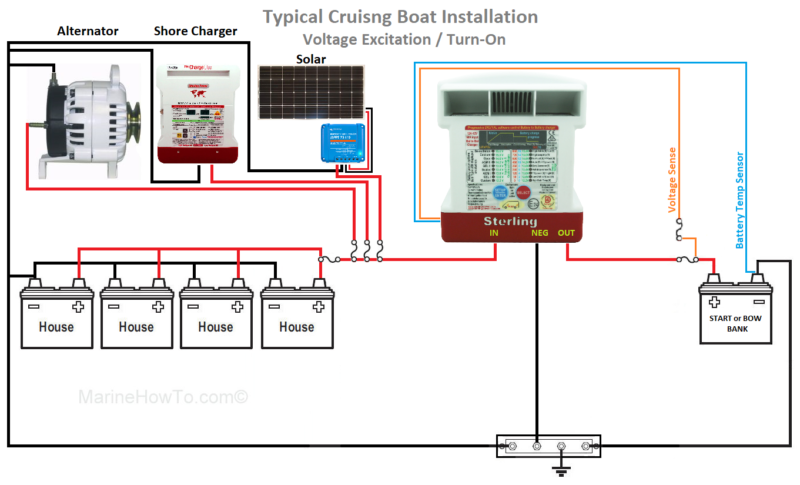 As can be seen above the typical marine installation is just 5 total wires or 6, if you purchase the optional remote display:
As can be seen above the typical marine installation is just 5 total wires or 6, if you purchase the optional remote display:
- Temp Sensor
- Volt Sense
- Output Positive
- Input Positive
- Negative
- Remote Display (optional)
You may be wondering why we took so many man-hours to create all these diagrams? The answer is actually quite simple, the Sterling Power manuals are rather difficult for most owners to make sense of. Even we had to send Charlie Sterling a rather long list to get clarification on some of the wording. Please understand that Charlie is an electrical engineer, and writing manuals for the non-electrical engineer boat owner can be very difficult, to convey clearly, to a DIY. Sterling is not alone in this regard and it is common in the industry. We know the manuals can be difficult because we get the support calls & emails before our customers ever reach out to Sterling Power. Almost always it is just a misunderstanding of the instruction manual, not an actual problem with the product.
Sterling Powers main market for the Pro Batt Ultra is for “caravans“, or RV’s & Trailers to those of us in the USA. In order to cater to this market the product needs to be in compliance with the Euro 6 Emission Standards. In Euro 6 installs the B2B’s are connected to the vehicles starter battery and feed the trailer or RV’s hotel/house battery bank. Due to Euro 6 regulations you can’t really tinker with the alternator and many of these are now controlled by the vehicles CPU to work in concert with regenerative braking etc..
The Pro Batt Ultra allows for regenerative braking / Euro 6 compliance. In short, the stock alternators do a horrible job of charging deeply cycled house banks in the trailer or RV, and you can’t really modify them. The good news for Euro 6 installations is the auto and RV recreational industry typically over-size most alternators, and this results in a very low warranty rate. It also means there is room left over, in terms of amperage, for the B2B charger to pull from.
Bottom Line on the Owner Manual?
For a marine application please ignore the vast majority of the Pro Batt Ultra manual that primarily deals with Euro 6 compliance. We have asked Sterling Power for a Pro Batt Ultra marine only manual but so far no luck.
Input Bank Charge Source Sizing:
Lead Acid Alternator Sizing – Sterling Power recommends that your alternator be sized (based on its SAE output rating) to be at least 30% larger than the B2B unit you choose. In our testing we found 30% to be a bit low for many “stock” alternators and find that double the B2B size means a much cooler running alternator. The reason for this is actually quite simple, you don’t want to tax your small alternator to death. Alternator output also varies based on RPM and winding temp. We see small alternators taxed to death quite regularly on boats.
Unlike automobiles, marine alternators are typically grossly undersized for the work they are expected to do. On the flip side, automotive alternators are typically grossly oversized for the work they are expected to do. As an example the stock alternator in my truck is a 150A Denso hairpin wound unit that’s charging a single G24 starting battery. With every device on max the most I have measured for alternator loads is about 28A. That same alternator, charging a 600Ah house bank, would be at maximum output for close to two hours straight. Most owners of marine engines would kill for a 150A rated alternator instead of the grossly undersized 35A-80A alternator many marine diesels are shipped with.
LiFePO4 Alternator Sizing – If you intend to feed a LiFePO4 battery bank with a ProBatt Ultra, and many do, then Sterling’s suggestion of 30% over-sized, for the alternator, we find to be rather inadequate. We recommend at least double the alternator rating, or larger for the B2B charger. So, if you want to use a 30A B2B on LiFePO4 then you would need an alternator rated at a bare minimum of 60A but preferably one sized for 80A would be much better. Each engine bay, and its heat characteristics, will be different, so predicting how much larger is impossible to really say. In our experiments with stock alternators we find double the B2B input rating for the alternator is a bare minimum.
The best scenario with LiFePO4 is to upgrade your alternator before using a Sterling B2B to feed your LiFePO4 bank.
Shore Charger Sizing – Like the alternator, consideration needs to be given to the demand placed on it by the Pro Batt Ultra. Can the charge source handle it? If the charger can run at 100% of its output rating, and do so continuously, and not all chargers can do this, there is little need to over-size by more than 30%. If however, like some AC chargers, it will limit output if it gets too hot you may want to consider upping it to 40% – 50% larger than the B2B input rating. Again, if feeding LiFePO4, this will need even more examination as demand on the Pro Batt Ultra will be near 100% during the vast majority of the LiFePO4 charge cycle.
Alternative Energy Charging – This will be entirely up to you the owner as to how you choose to use the Pro Batt Ultra. With smaller arrays we generally advise ignition excite, it charges start or bow bank when the engine runs, but if you have a large array, voltage excitation can certainly work.
Just try to ensure your charge sources can exceed the demand placed on the B2B by the target bank. In situations where the B2B is charging only a start battery, this is not going to be a big deal, start batteries require very little charging hence little demand on the source bank charger, but as the target bank requires more current, such as a bow-thruster bank or LiFePO4 it can cause B2B on/off cycling so charge source sizing becomes more critical.
Ignition Excitation
For some situations, such as LiFePo4, or a low current PV system, an owner may want the B2B to run when the engine is turned on, even if the input voltage is below the “automatic” turn on point of 13.2V. This is called “ignition excitation” or “key-on excite“. If ignition excite is used the unit can boot up and start charging a target bank with input voltages as low as 10V. The image below shows where the +12V ignition feed would be wired to. To use “Ignition Excitation” all that is required is one wire from the run position of the engine switch.
In this image we can see the ignition terminal of the B2B connected to the “run” position of the engines key switch. When the engine is fired up, there is a brief delay, and then the Pro Batt Ultra will boot up and begin charging the target battery.
Voltage Excitation / Activation
The Pro Batt Ultra (green stripe models) comes out of the box ready to be used in automatic voltage activation mode. By not using the ignition terminal the unit will only turn on once voltage has attained the turn-on voltage of 13.2V, and a short delay timer clock has been run out. The timer delay is to prevent on/off cycling as the bank approaches the voltage turn-on level. The on voltage and cut off voltage can be adjusted up or down but there will always be a 0.2V spread between the ON & OFF points. An adjustable turn-on voltage can be handy when dealing with a LiFePo4 house battery, that may be the “source bank”, and will have a significantly higher resting voltage than lead acid batteries do. In this case increasing the automatic voltage activation point to 13.5V – 13.6V will mean the B2B only boots when the LiFePo4 battery is actually being charged, but don’t forget that the OFF voltage is always 0.2V lower than the ON voltage.
For example; ON = 13.2V and OFF = 13.0V or ON = 13.6V and OFF = 13.4V
What about quiescent current draw?
The nice thing about the Pro Batt Ultra is that it automatically puts itself to sleep when input voltage is below the TURN OFF voltage set point (13.0V as it ships). If you fit a remote display the remote also goes to sleep. The quiescent draw or parasitic load that’s placed on the source battery, when the unit is sleeping, is just 1mA! 1mA = 0.001A. In an entire week asleep on standby the unit uses just 0.168 Ah’s. Pretty amazing really.
Alternative Uses for the ProBatt Ultra – LiFePO4
With LiFePO4 drop-in batteries now being heavily marketed, and prices falling to an acceptable level for many boaters, there are issues that can arise that need to be addressed before you can simply “drop them in“.. These issues involve “drop-in” type LiFePO4 batteries that feature a 100% sealed non-communicable internal BMS (battery management system). The problem is not how the BMS manages the battery, it is in its ability to disconnect the battery from the vessel & charge sources. With most drop-in LFP batteries this can happen without any advanced warning.
An LFP drop-in batteries internal BMS can disconnect for the following reasons:
- Cell Over Voltage
- Cell Under Voltage
- Cell Temperature
- BMS Temperature
- BMS Current Limits Exceeded
If there is a bad cell, temperature too high, too much charge current, a glitch in the charging voltage settings or a cell imbalance issue creating an over-voltage condition, the battery will physically disconnect itself from the vessel. Most drop-in LiFePO4 batteries can disconnect themselves with no advanced warning to the vessel occupants. This is called a load disconnect or load dump.
A load disconnect or load dump is something a lead acid battery can’t physically do on its own, so this, by definition makes “drop-in” LFP batteries not so “drop-in” because we now need a ways to ensure our alternator or inverter/charger is not suffering load dumps. Of course you don’t need to take out word for it, so how about Balmar, the worlds largest specialty marine performance alternator and regulator manufacturer.
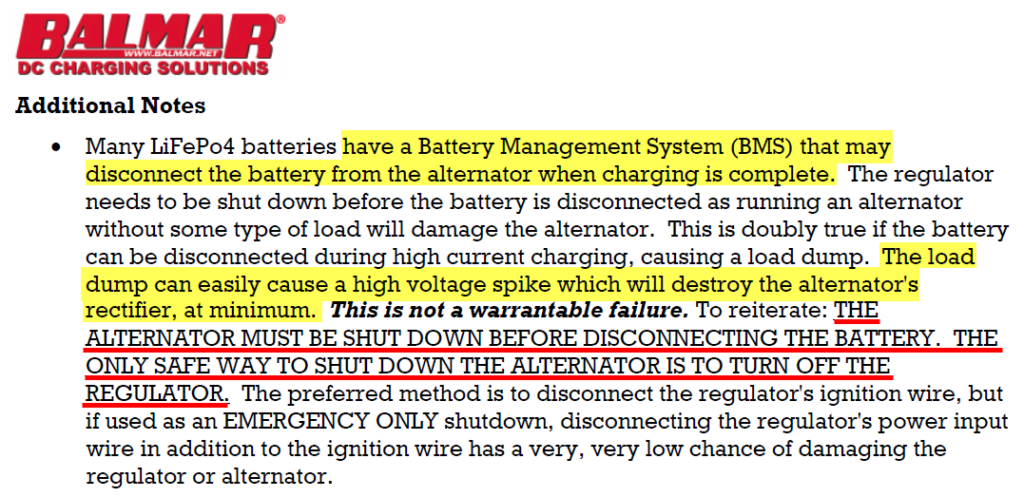
Sure, many an owner has moved a battery switch with the alternator charging and had the destroyed alternator to show for it but the battery did not do this without warning, and the owner made a simple, and often fatal to the alternator, mistake. If a BMS disconnect / load-dump occurs, when charging with an alternator, or even a large transformer based inverter/charger, the resulting *voltage transient, can damage the charge source and also what ever is connected to the DC bus/system such as sensitive marine electronics.
*Voltage Transient – What occurs when a charge source such as an alternator is suddenly disconnected from the load (battery). The current now has nowhere to go sending the voltage through the roof. When the load (battery) is suddenly disconnected the voltage skyrockets to damaging levels in milliseconds.
During normal operation the alternator operates normally: (most drop-in batteries have the BMS disconnect on the negative side of the battery)

In a fault condition this is what can happen to the alternator:
What a load dump can look like:
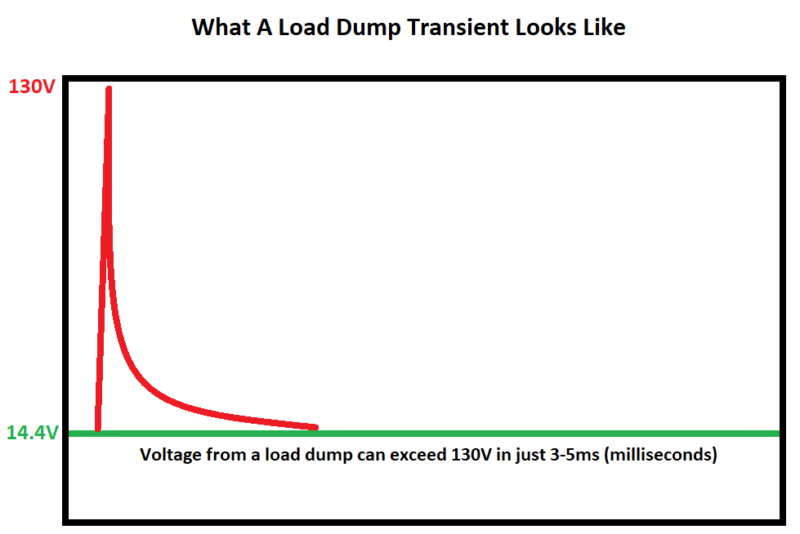
How does the Sterling ProBatt Ultra play into this?
The unique aspects of the ProBatt Ultra are in its ability to:
- Have a charge profile that is suitable for LiFePO4 (many lead acid charge sources are not ideally suited for LFP)
- Can withstand a load dump
This image below is why, when discussing the ProBatt Ultra, I prefer to use the terms SOURCE BANK and TARGET BANK. As can be seen we have reversed the way we would typically use the ProBatt Ultra in a lead acid installation and now the start battery is our source bank and the ProBatt Ultra feeds the LiFePo4 bank or target bank.
Using A Lead Acid Start Battery As The Source Bank
In this image the stock alternator remains connected to the start battery and the DC to DC charger charges the LiFEPO4 bank This avoids the need for external regulation because the DC to DC charger can be set for LiFePO4 where your stock alternator is not. Always remember that the DC to DC charger should be no more that 50% of the alternators output rating or you can kill your alt through heat damage!
“But RC a BB1260 is not enough charge current for my LiFePO4 system?”
Not a problem, simply parallel two or more Pro Batt Ultras together, providing your input charge sources are 30% larger or more, and you can now charge at significantly higher amperage.
While the ProBatt Ultra has been designed to withstand a load dump, other items on-board your vessel, connected to the loads bus, may not be. This is why we recommend a Sterling Alternator Protection Device for every vessel or RV etc. that has drop-in LFP batteries. The Alternator Protection Device clamps the transient to a safe level. We have tested these in our shop, on our alternator test bench, to 130A and not been able to kill one. Installation is very simple & straightforward two wire connection done close to the alternator B+ & B- terminals as shown below:
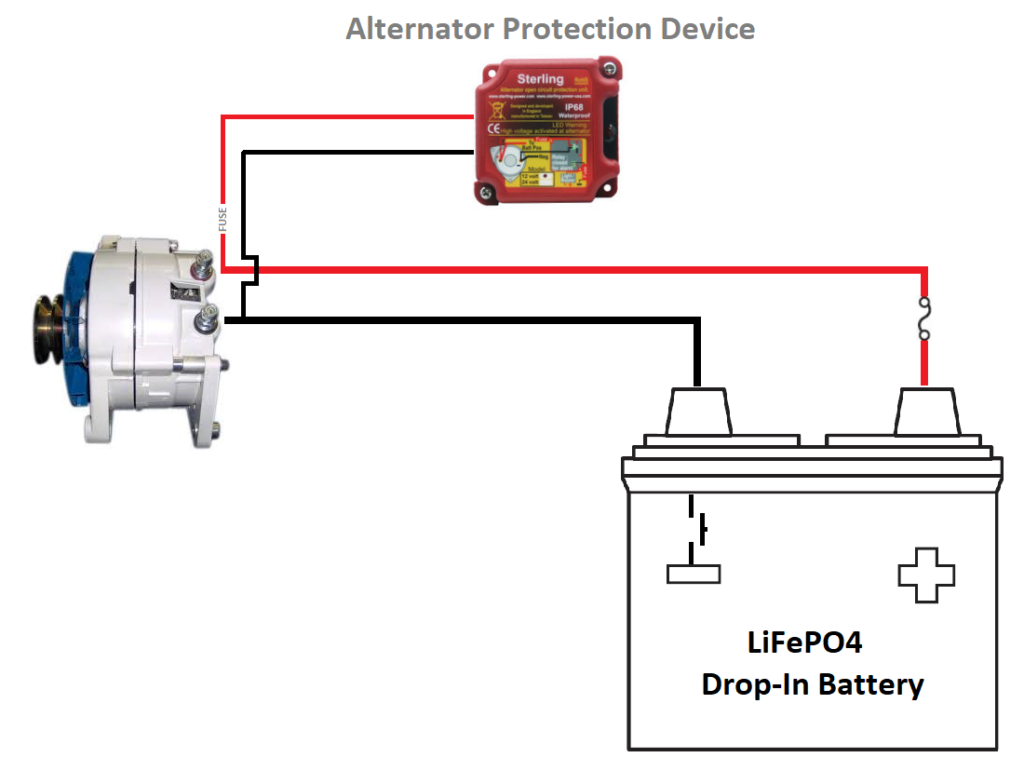 If you’re installing LFP drop-in batteries a Sterling Power Alternator Protection device is a must-have item:
If you’re installing LFP drop-in batteries a Sterling Power Alternator Protection device is a must-have item:
Remote Display
Like any charge management device they are often installed where you can’t see them, and don’t know what is really going on. The optional BBURC is the remote display for the Pro Batt Ultra. It displays charge stage, input voltage, output voltage, unit temperature and battery temperature. It can also be set to alarm a user of a fault condition.
The words remote displayare meaningful because the BBURC is, unfortunately, not for programming the unit. Sterling Power keeps programming at the B2B charger so folks can’t fiddle with the remote and change settings. Little kids love to push buttons. Programming via the remote would be nice but I do fully understand the hesitation. Perhaps in the future there will be a lock-out on the remote to stop roaming fingers from changing settings?
Pro Batt Ultra Likes & Dislikes
No product is 100% perfect and we won’t pretend the Pro Batt Ultra is, but it is quite good and certainly a “best in class” product. Here at Compass Marine Inc. we are big fans of the Pro Batt Ultra because it can do things no other charge management device can.
Likes:
- Dedicated Voltage Sensing
- Adjustable Absorption Duration
- Forced Float Option
- Optional Remote Display
- 1 mA Parasitic Draw When in Sleep Mode
- Can Equalize
- True Fully Independent Multi-Stage Charging Output
- Buck or Boost
- 12V & 24V Mixed Voltage Models
- Compact Size for the Amperage
- Temp Sensor Included
- Can Withstand a Load Dump
- Ignition Excite Option
- Fully Custom Programmable
- Easy to Install
- Best in Class Product
- Pricing is Very Competitive
- Good for Drop-In LiFePo4 Charging
- 2 Year Warranty (many other DC to DC chargers are 90 Days)
Dislikes:
- Owners Manual
- Programming is a Bit Kludgy
- Terminal Strip Orientation for Temp/V-Sense/BMS is Awkwardly Located
- Fan Noise (only when working hard)
- Programming Buttons Vary in Location By Model
Overall the Pro Batt Ultra is a very unique product that no other company even comes close to. The Pro Batt Ultra is a product we are proud to offer to our readers in the MarineHowTo.com Web Store. Please remember the web store at MHT supports this site and keeps it FREE!
Keep articles like this coming by purchasing our recommended products from our affiliate partners
BUY PREMIUM QUALITY DC TO DC CHARGERS – AMAZON
BUY PREMIUM DC TO DC CHARGERS – BAY MARINE SUPPLY
Happy boating!
Emergency!
We do not want to put this website behind a pay-wall!
Unfortunately, that is where we’re headed if our readers don’t help us with donations…
Please make a donation, that’s all we ask. Your donations are all we have to fund this web site. Please help to keep MarineHowTo.com a
FREE source of information!

